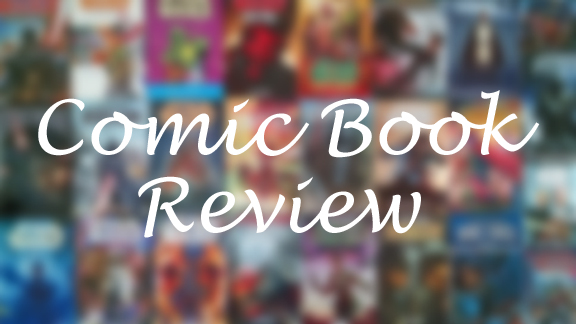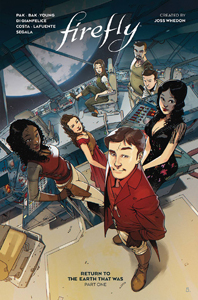Writer Greg Pak writes an epic and satisfying finale to his run on Boom! Studios’ “Firefly” with “Return to the Earth That Was” (Issues 25-36, 2021, collected in Part One, Part Two and Part Three). To do so, he jumps ahead on the timeline from “Blue Sun Rising” – which is set before the “Serenity” movie, as Haven is being settled – to after the last Dark Horse title, “No Power in the ’Verse.”
Part of the appeal of tie-in comics is filling in story gaps between the more “official” movies and TV series, but here Pak creates some new questions. They aren’t plot holes, per se, but they are unfilled gaps in the timeline. The following story points are skipped over due to this time jump:
- Why does Leonard leave the crew (during the time of “Serenity” and the subsequent Dark Horse comics), then return for this arc? Similarly, why are the crew members exclusive to the Dark Horse storyline now absent?
- What happened in the Third Unification War? Dark Horse was leading up to this event. We can assume the Alliance won and became even more powerful.
- Who creates the Washbot – and how and why?
- How are space-jump portals in existence and operational again? These were used to transfer humans from Earth to the ’Verse 500 years ago, but they had been lost to history. Now they are suddenly back.
- How and why does Kaylee become captain of Serenity? Is there a decisive event that causes Mal to go off and become a depressed hermit, or is it just an accumulation of his whole career and life?

“Firefly: Return to the Earth That Was” (2021)
Issues 25-36, Boom! Studios
Writer: Greg Pak
Artists: Pius Bak, Ethan Young, Simona Di Gianfelice, Jordi Perez, Johnoy Lindsay
Colorists: Marcelo Costa, Joana Lafuente, Francesco Segala, Johnoy Lindsay
While I’m not thrilled that Boom! decided to jump forward on the timeline, leaving these story gaps, I must admit that Pak creates a moving story nonetheless. The Washbot serves as both an instrument (he can pull apart the innards of machines – infernia, as the Earthers call them – and an emotional trigger for Zoe. He serves the same purpose Illyria served for Fred’s friends on “Angel.” Zoe has a ringer for her deceased husband right in front of her.
Captain Kaylee
The pressures of captaincy are well illustrated by Kaylee’s tough choices, while a bearded Mal is in the background saying this is why he can’t do this anymore. Again, it’s reminiscent of the stretch on “Angel” where Angel backs out from a leadership role.

Mal’s inner journey is a fair portrayal of some blend of PTSD, anxiety, depression, introversion and guilt. Pak uses it to show Inara’s deep caring for him. If this were to be the last Mal-Inara story on the timeline, it’s a fine grace note.
The sudden appearance of the portals is undercooked, although I understand that Pak is more interested in character building than world-building. He focuses on the classic characters. Comic-exclusive characters such as Leonard, Lank, Stev and Maggie are shunted aside to the point where I wonder if Pak originally planned to do more with them and had his issue allotment cut short. Still, they are a nice presence for the sake of making the group more robust.
The portals allow for everyone to go to Earth That Was. Then we launch into a “Valerian”-tinged love-of-nature story, except with a touch of bias against technology (which is understandable, given the lives everyone has lived under the thumb of the Alliance and Blue Sun).
Lead illustrator Simona Di Gianfelice and lead colorist Francesco Segala deliver the best art of the Boom! run. They take a breath every now and then for two-page spreads of four horizon panoramas showing how happy everyone is with the communal, tech-free life on Earth.
The planet will be fine
In the 500 years since humanity left, the Blue Planet recovered; as George Carlin said, “The planet isn’t going anywhere. We are.” A much smaller population of humans has sprung up, conveniently speaking English but with new words peppered in. This is a smart detail from Pak, who has for some reason been loath to use Mandarin swearing in his scripts.
Kaylee is able to talk things out with Earther Jefa Orangeles, as Pak takes an appealing Pollyana angle on the Europeans-Indians confrontation. The story has a touch of “Valerian” in the way River is delighted by the “chippies” (chipmunks) that nest in the damaged Serenity’s innards.
The brash fact that our characters literally return to Earth-That-Was – a place of myth in the “Firefly”-verse till now (although the novel “Generations” does explore the ruins of a colonization ship) – is in and of itself a big hook, of course. In this regard, the title trips up a bit, mainly because of marketing.
It’s four issues into the 12-issue series before our crew ends up on Earth-That-Was, but because the arc is called “Return to the Earth That Was” the whole time, the surprise factor is gone. (Granted, I’m referring to the collected volumes. It’s possible that the individual issues up through No. 28 don’t go by this title.)
The revelations once on Earth-That-Was are notably nonchalant – even when an aspect of Wash’s family’s past is revealed in South Dakota – although Pak and Di Gianfelice do deliver a grand sort of poetry to the experience. Inevitably, the myth is gone and Earth is now just another planet in the ’Verse.
Overblown marketing
Boom’s marketing decisions have always been overblown – resulting in every arc being labeled “New!” in some fashion – and the back cover of Part Three says the Alliance is threatening Earth. Because of the portals, this is a possibility, but it remains off panel. I don’t disagree with Pak’s choice, as I’m happy that Orangeles and her people have a chance to make Earth great again.
Still, those portals are too major of a plot device to brush over. Oddly, they make the galaxy somewhat smaller in “Return to the Earth That Was.” In the long run, though, they could make it bigger. They could represent an opportunity for non-authoritarians to find their little slice of freedom in future stories.
Pak has said his piece, though. A new writer takes over for the next arc, “Brand New ’Verse,” which begins a new numbering sequence. Pak can be proud of these 36 “Firefly” issues (plus various one-shots) that make him the longest-tenured writer in the ’Verse.
Perhaps we’ll never know if Pak was mandated by Boom! to do certain things with the potentially lucrative “Firefly” title. His first two arcs, “The Unification War” and “New Sheriff in the ’Verse,” seem intentionally decompressed, as if to maximize issue sales.
But whatever the case, his last two arcs – “Blue Sun Rising” and “Return to the Earth That Was” – show his strong grasp of the Serenity crew’s personalities and a willingness to take narrative chances. Almost as crisp as the storytelling from Dark Horse (although with art that’s a notch below), these arcs find that sweet spot of being unpredictable while still slotting into the vibe and themes of the ’Verse.

